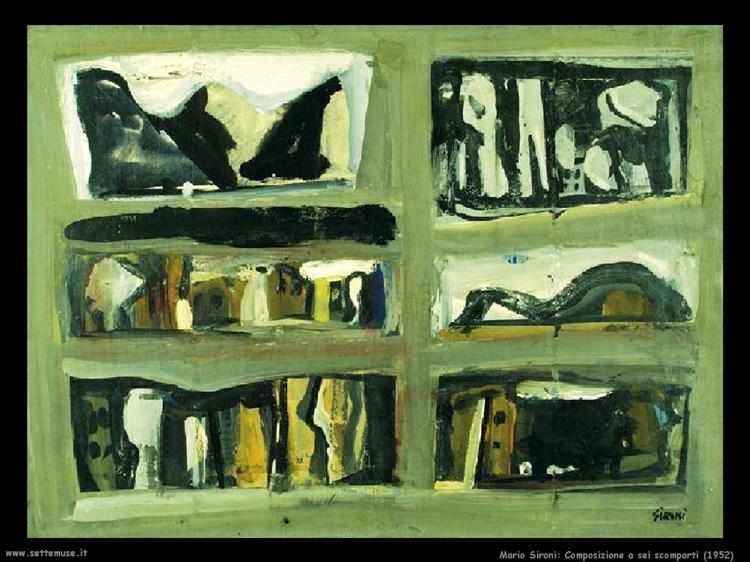Gallery Guide Susan Morrison continues her multipart series on the contributions of the AGO’s Women’s / Volunteer Committees to the gallery’s collections. This week: The Women’s Committee shifts its acquisition focus.

Mario Sironi, Composition of Six Sections (1952) – One of the artists whose work was selected for purchase (but not bought) from the 1952 Carnegie International
Attached to the minutes of the Oct 27,1952 meeting of the Women’s Committee is a fascinating six-page report from the chair of the Purchasing Committee, Mrs Arnold Matthews, concerning a buying trip to the 1952 Carnegie International Biennial Exhibition of Contemporary Painting in Pittsburgh eleven days earlier.
Mrs Matthews, along with the Art Gallery of Toronto’s (AGT’s) director, Martin Baldwin, chief curator Sidney Key, and Mrs Hendrie, the WC Vice President, had travelled to Pittsburgh with two goals in mind. First: to buy one “significant” painting with $3500 raised specifically for the purpose of honouring the AGT’s Jubilee year of 1953, and second: to spend $1400 from the Purchase Fund on a few other “suitable” artworks.
The group arrived early to the juried show and, from the 300 paintings on display, chose one deemed “an important work by an established artist” plus others. However, to their great disappointment, they found out that the Carnegie Institute had first choice of purchase, and had selected the same artworks as the AGT! As Mrs Matthews stated at the time, it seemed that everyone wanted the same small group of paintings by established artists. And so the AGT came away empty-handed.
Faced with this unsuccessful venture, Mrs Matthews reflected on the reasons for this unhappy outcome. Given that 90% of the artworks were abstract, and most of the painters were little known, she pointed the finger at the reluctance of gallery buyers – the AGT group included – to take chances with new and challenging art.
The dilemma facing the purchasing committee, she claimed, was that contemporary (i.e. abstract) pictures were bound to be controversial, and that the majority of the WC would consequently dislike them. If the Purchasing Committee were to purchase this kind of art, she imagined the WC members’ response to be:
1. Why do we buy such dreadful art?
2. Abstract art is incomprehensible.
3. How can we the WC justify our purchases of such pictures to conservative friends and fellow members of this gallery?
Mrs Matthews’s rebuttal to this was to present two options. On one hand, if the WC chose to stick with safe art by established artists, they would have to raise a lot more money in order to be able to buy the work. On the other, they could take a chance with the new generation of contemporary abstract artists whose prices would be more affordable. After all, she added, if they ended up not liking the work they could always sell it later for another.
Nevertheless, in spite of her heartfelt plea for taking a chance on the new, it wasn’t until 1959 that the WC started to purchase more challenging contemporary art. The Jubilee Funds were later used to buy Raoul Dufy’s Le Port du Havre 1905-6, currently on display in room 137.
This series will continue in the fall, with more fascinating twists and turns!
Next time: Case Studies 1: Franz Kline’s Cupola
Read the previous installment here.
